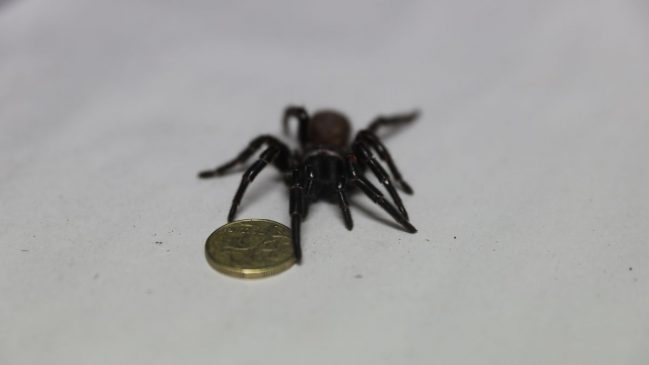Funnel-web spiders are typically half the Megaspider’s size.

What has eight legs and fangs powerful enough to bite through a human fingernail? “Megaspider,” an enormous funnel-web spider that was recently captured in Australia.
The Australian Reptile Park (ARP) in New South Wales is a public zoo that also houses a collection of funnel-web spiders; keepers milk the spiders for their venom, which is then processed to create anti-venom. This particular spider was donated by an anonymous benefactor and arrived last week at the park in a plastic tub as part of a weekly collection from spider drop-off points near Sydney, the Central Coast and Newcastle, ARP representatives said on Nov. 11 in a statement.
Even seasoned spider keepers were astonished by the spider’s size, according to the statement. The giant arachnid measured just over 3 inches (8 centimeters) from foot to foot — most funnel-web spiders are typically between 0.4 and 2 inches (1 and 5 cm) wide — and its curved fangs were 0.8 inches (2 cm) long.
“In my 30+ years at the Park, I have never seen a funnel web spider this big,” Michael Tate, an ARP education officer, said in the statement. Park keepers promptly named the sizable arachnid female “Megaspider,” but they don’t know where she was found or who captured her; she had been boxed up in a Tupperware container without any labels or information about her captor, and there were no clues to connect her to any of the drop-off sites along the route, according to the statement.
“We are really keen to find out where she came from in hopes to find more massive spiders like her,” Tate said.
Funnel-web spiders — which comprise about 40 species in the genera Hadronyche and Atrax — live in eastern Australia, and some species deliver a bite so toxic that it can kill an adult human within 15 minutes, according to the Australian Museum. All funnel-web spider species have glossy, nearly hairless bodies that vary in color from brown to deep black, and they have eight eyes arranged in two rows of four eyes each. The spiders are active year-round and live in burrows in moist, cool habitats, surrounding their tunnel openings with a network of silk strands. When a passing insect or other animal touches the silk, the vibrations alert the spider in the burrow, according to the Australian Museum.
ARP is Australia’s only source of raw funnel-web spider venom for anti-venom serum production, according to the park statement. Keepers milk the spiders weekly and then ship the venom to a lab in Melbourne that produces the anti-venom by injecting very small doses into rabbits, so that the animals develop antibodies. These antibodies in the rabbits’ blood can then be processed into a serum that neutralizes the venom’s toxins in humans, according to NPS MedicineWise, an Australian nonprofit funded by the national Department of Health.
Since the ARP program began in the 1950s, its anti-venom is estimated to have saved 25,000 Australians who were bitten by funnel-web spiders, and the antidote still saves approximately 300 lives each year.
Recent rainy weather and intense humidity in eastern Australia has created highly favorable conditions for the continent’s funnel-web spiders, according to the statement. Members of the public who wish to safely collect spiders for the anti-venom program are advised to exercise extreme caution, by using glass jars (which the spiders can’t climb or jump out of once they’ve been captured) and wearing protective clothing, such as gardening gloves and long pants, according to the New South Wales Department of Planning, Industry and Environment.
The park is especially interested in supersize arachnids like Megaspider, which have bigger reservoirs of venom for the milking program, Tate said.
“If we can get the public to hand in more spiders like her, it will only result in more lives being saved due to the huge amount of venom they can produce,” he said.
